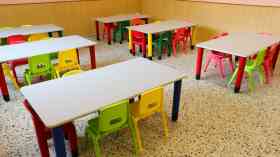
Understanding fire safety duties
The devastating effects of the recent fire at Selsey Academy have underlined the importance of the correct fire safety measures and procedures in any building used by the public
The recent case of the fire at Selsey Academy School in August has placed fire safety in schools on the national agenda once more. The devastating effects of the fire have served to underline the importance of the correct fire safety measures and procedures in any building used by the public.
The Fire Protection Association has been helping schools meet their fire safety responsibilities for some time. Below we have revisited some of the advice in our popular Fire Risk Management in Schools handbook and outlined some of the ways we can help schools stay safe from fire.
Your responsibilities
Health and safety legislation requires the ‘responsible person’ to ensure the safety of all occupants of public buildings and workplaces.
Schools and educational premises differ from other premises in that they are required to provide a safe learning environment for children and young people that are not accompanied by their parents or guardian. Therefore both fire and security are important considerations – not only must the children/students remain safely on the premises, but outsiders or potential intruders must be kept off the premises. There can be conflict between the requirements for evacuation in the event of a fire and keeping occupants and premises secure.
The physical and mental maturity and mobility of the children will cover a wide spectrum and may also include individuals with a wide range of physical disabilities and/or special needs.
Schools are often designed and built to minimise costs whilst providing an adequate level of fire safety for the occupants. This can result in minimal fire compartmentation within the building which, in effect, promotes the spread of smoke and fire should a fire start.
There may be inherent fire risks, for example ignition sources in science laboratories and metal workshops; cooking facilities in domestic science areas and kitchens; and high fire loads in lockers, cloakrooms and resource areas and stores. Other possible causes could come from readily ignitable material on notice boards and displays in class rooms and assembly areas, and waste paper and material which has been segregated for recycling and is susceptible to deliberate ignition. Plastic or wooden chairs and tables – whether stacked at the back of the hall or dining room or set out for assembly or examinations – may also present large fire loads.
The Legislation
In England and Wales, the relevant legislation is the Regulatory Reform (Fire Safety) Order 2005. In Scotland, the relevant legislation is two-fold, being Part 3 of the Fire (Scotland) Act 2005 and the Fire Safety (Scotland) Regulations 2006. While in Northern Ireland, the relevant legislation will be Part 3 of the Fire and Rescue Services (Northern Ireland) Order 2006 and the Fire Safety (Northern Ireland) Regulations 2006.
In essence, each of the above pieces of legislation has the same intention of ensuring that all ‘relevant persons’ will be safe should a fire occur in ‘relevant premises’. The following important terms are generally defined in all parts of the UK as follows. ‘Relevant persons’ are any persons that are legally within ‘relevant premises’ or any persons that are or may be in the vicinity of ‘relevant premises’. ‘Relevant premises’ are essentially any premises other than a single domestic dwelling.
Design and structure of buildings
Fire safety legislation has a significant impact on the design and structure of buildings and on working practices. The Building Regulations – typically implemented through adherence to the guidance provided in Approved Document B to the Building Regulations in England and Wales – apply in new build, extensions to an existing building or a ‘material’ change of use.
These control the design, layout, construction materials and separation of buildings so as to limit fire spread by creating fire-resisting compartments and ensuring that people within the building are made aware that there is a fire and are able to make their way to a place of safety without becoming casualties of the fire. Similar regulations apply in Scotland and Northern Ireland.
Management of fire safety
The emphasis on fire safety is now very much on fire prevention and reducing the risk of fire. Responsibilities under the Order impact on everyone in the workplace, including the employer, the employees, contractors, visitors and volunteers. The Fire Safety Order differs from previous workplace-related regulations in that there is no longer any distinction made between people who are employees and, say, members of the public or voluntary workers at an entertainment venue.
It includes people who have a disability and anyone who needs special assistance to enable them to make their escape in the event of fire. Risk assessment is now the norm for dealing with the prevention of all types of accidents. This highlights a move away from the use of clear prescriptive rules, to an approach where aspects of health and safety, in particular, are performance based.
Responsibility is transferred from officials to a particular individual within each company – the ‘responsible person’ in England and Wales, ‘the employer’ in Scotland and ‘a person who has control to any extent of relevant premises’ in Northern Ireland – in a regime based on self-certification. The overall requirement is that the risk to people from fire in buildings should be as low as reasonably practicable.
Health and safety law dictates that each building has a responsible person. This could be the head teacher/dean or it could be an appointed health and safety or facilities manager. Whoever it is, your school/college/university will need to ensure that fire safety responsibilities are met.
How the3 FPA can help
The Fire Protection Association (FPA) is the UK’s national fire safety organisation and has been helping educational organisations manage their fire safety responsibilities for over 60 years.
Facilities managers, health and safety managers and other responsible people benefit from having robust written resources at their command. The FPA offer a collection of resources which offer education professionals practical advice on fire safety, including a fire safety in schools DVD and a fire safety in schools Training Information Pack (TIP).
The above resources are available at thefpa.co.uk/shop, however most are available free of charge to FPA members at SME level or above.
Training
It is a legal requirement to ensure that the responsible person is competent for his role and that all staff are informed of plans in the event of fire. If your staff require fire safety training, there is no more experienced organisation to provide them with the skills they need. Courses include:
Certificate in Applied Fire Risk Assessment; Fire Safety for Fire Wardens; Management and Maintenance of Fire Systems
What’s more, the FPA can offer a number of consultancy options to help organisations meet their legislative requirements. Options include fire safety strategy advice, including evacuation plans, risk assessments, supplier management; and fire risk assessments.
Further Information:Latest News
19/12/2025 - 09:54
The Education Committee has expanded its ongoing inquiry into the early years sector to examine how safeguarding can be strengthened in early years settings.
18/12/2025 - 09:25
The UK will be rejoining the Erasmus programme in 2027, following a package of agreements with the EU.
17/12/2025 - 09:31
Ofqual has fined exam board Pearson more than £2 million in total for serious breaches in three separate cases between 2019 and 2023 which collectively affected tens of thousands of students.
16/12/2025 - 09:19
The average funding rates will increase by 4.3% for under 2s, and by almost 5% for 3-and-4-year-olds.
15/12/2025 - 10:30
Local colleges are set to receive £570 million in government funding to expand training facilities in areas such as construction and engineering.







